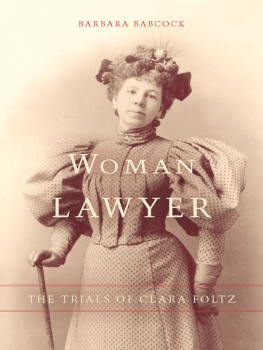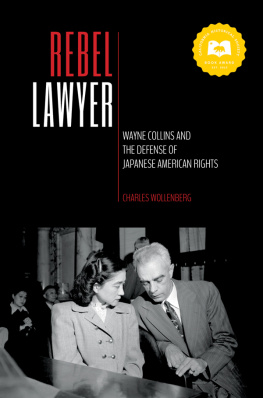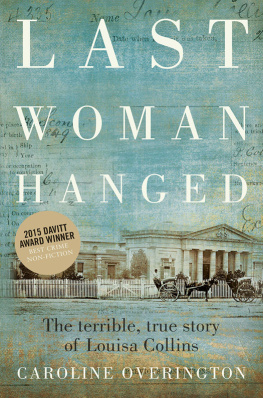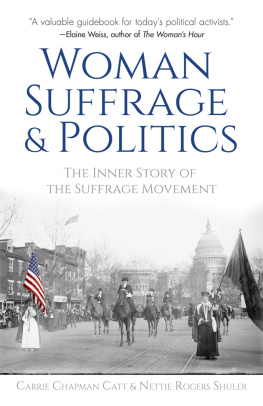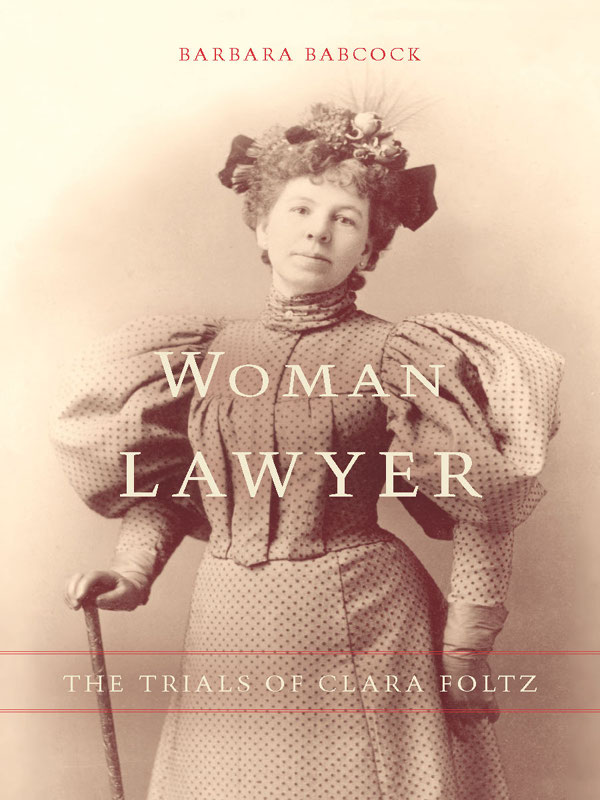Woman Lawyer
Woman Lawyer
THE TRIALS OF CLARA FOLTZ
Barbara Babcock
Stanford University Press
Stanford, California
2011 by the Board of Trustees of the Leland Stanford Junior University. All rights reserved.
No part of this book may be reproduced or transmitted in any form or by any means, electronic or mechanical, including photocopying and recording, or in any information storage or retrieval system without the prior written permission of Stanford University Press.
Special discounts for bulk quantities of Stanford Business Books are available to corporations, professional associations, and other organizations. For details and discount information, contact the special sales department of Stanford University Press.
Tel: (650) 736-1782, Fax: (650) 736-1784
Printed in the United States of America on acid-free, archival-quality paper
Library of Congress Cataloging-in-Publication Data
Babcock, Barbara Allen.
The trials of Clara Foltz / Barbara Babcock.
p. cm.
Includes bibliographical references and index.
ISBN 978-0-8047-4358-7 (cloth : alk. paper)
1. Foltz, Clara Shortridge, 18491934. 2. LawyersCaliforniaBiography. 3. Women lawyersCaliforniaBiography. I. Title.
KF368.F585B33 2011
340.092dc22
[B]
2010037262
Typeset by Bruce Lundquist in 10.5 /14 Adobe Garamond
E-book ISBN: 978-0-8047-7935-7
Contents
Preface
Clara Foltz was one of the first women lawyers in the United States, and for a time one of the most famous. From the day of her admission to the bar in 1878, she was often in the newsarguing to all-male juries, stumping in political campaigns, and working for woman suffrage, penal reform, and other causes. She had a large part in the adoption of the first guaranties of equal access to employment and education in U.S. constitutional history, pioneered the public defender movement, and practiced law continuously for fifty years. In everything she did, Foltz enjoyed remarkable celebrity, partly because of the human interest of her personal situation. She was a single mother of five children and became a lawyer in order to support them as well as to find personal fulfillment and advance womens rights.
Despite the lavish attention during her lifetime, however, Foltz was largely forgotten until recently. The revival of her reputation started with the rise of the second womens movement in the 1970s, which brought a surge in the number of women attending law school. Almost overnight, the percentage of female students rose from 3 to 20 percent, and today it is nearly 50 percent. When all at once they became a large part of this important profession, women found themselves without a history to guide and to inspire.
Clara Foltz was one of the first beneficiaries of the interest these students and their male allies took in finding models and perhaps heroines for the new generations of women lawyers. In 1976, almost one hundred years after she successfully sued Californias first law school for refusing to admit women, its law review featured an article about her extraordinary life, coauthored by a male professor and two female law students (Mortimer D. Schwartz, Susan L. Brandt, and Patience Milrod, Clara Shortridge Foltz: Pioneer in the Law, 27 Hastings Law Journal 545). In 2002, the revival of interest in this pioneer woman lawyer reached a new level, when the central criminal court building in Los Angeles was renamed the Clara Shortridge Foltz Criminal Justice Center. Justice Sandra Day OConnor was the lead speaker at the dedication ceremony, which honored the accomplishments of women lawyers, and Foltz as first among them. My pleasure on behalf of my subject was only slightly dimmed by the query in the Los Angeles Times: Clara Who? In this book, I try to answer that question, and to examine the full dimensions of her achievement.
Though Foltzs personal papers did not survivea serious loss to a biographershe left behind an extensive public record. Her story is in court records, her own publications, biographical indexes, and perhaps most of all in news accounts and interviews. Most of her publicity was favorable, largely because, long before public relations became a recognized occupation, Foltz was a genius at managing her image. With confidence in her abilities and belief in her destiny, she was a true western character: larger than life and prodigious in her enjoyment of the moment and in her ambitions for the future.
Her distinctive voiceoptimistic, figurative, hyperbolic, elevated but humorouscomes through not only in interviews and profiles, but also in the twenty-eight magazine columns she wrote when she was in her sixties titled The Struggles and Triumphs of a Woman Lawyer. Foltz took her title from the book Struggles and Triumphs: The Recollections of P. T. Barnum (1882). Like the famous circus impresario, she lived a life of great highs and considerable lows, and also like him, she was an open and tireless self-promoter.
Though often speaking of her sacrifices for womens causes, Foltz never quite fit the mold of selfless crusader. Unwilling to relinquish any possibility, she was determined to be an inspiring movement leader, a successful lawyer and legal reformer, a glamorous and socially prominent woman, an influential public thinker, and a good mother. The result of these often conflicting desires was a life so frantic and scattered that it resists a logical, well-formed narrative. Yet these very qualities make her biography particularly relevant now, both as cautionary and heroic tale.
In my research and writing about Clara Foltz, I have come to admire her courage and charisma. At the same time, I have confronted her flaws and mistakes in judgment, which I try to portray accurately and fullyto mix the hag with the hagiography. But in a sense, full detachment is not really possible; I have necessarily interpreted Foltzs life through my own experiencesas a trial lawyer, a public defender, a first woman, and a feminist. Though I cannot wholly follow her direction to her anticipated biographer to let wreaths of triumph my temples twine, I think she would approve of what I have done here.
The book is published at a moment when women lawyers have made gains that would have seemed incredible to most people in the past. Not to Clara Foltz, however; she predicted that women would win an equal place in the legal professionand even sooner than it has actually happened. Foltz also believed that women would change the profession for the better and hoped that her own busy career promoting constitutional rights for the criminally accused and civil rights for women would inspire and instruct. I hope so too.
Acknowledgments
So many people have contributed to this book that naming names puts me in fear of omitting someone. But I must risk it. In the past few months as I have been organizing and arranging old files, I have thought fondly of the long line of wonderful student research assistants who have been companions in reconstructing Clara Foltzs life. Our work began before the golden age of search engines, and my early helpers worked in library archives and courthouse basements, reading old newspapers on microfiche and yellowing legal documents: Judith Carrithers, Lucy Carter, Mary Erickson, Ilana Hollenberg, John Ingrassia, Linden Joesting, Lisa Lindalef, Kara Mikulich, Catherine Ruckelshaus, Frances Scibelli, Paula Solario, and Karen Zobell.

